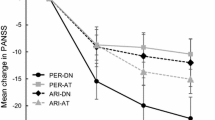Abstract
The benzamide amisulpride (ASP) is a selective D2-like dopamine antagonist, while flupentixol (FPX), a thioxanthene, blocks D2-like, D1-like and 5-HT2 receptors. To evaluate efficacy and safety of ASP and to investigate the importance of an additional D1-like antagonism for antipsychotic effects and extrapyramidal tolerability, a randomized double-blind multi-center study versus FPX as reference drug was performed for 6 weeks in 132 patients suffering from acute schizophrenia (DSM-III-R) with predominant positive symptomatology. Doses were initially fixed (ASP: 1000 mg/day; FPX: 25 mg/day) but could be reduced by 40% in case of side effects (mean daily doses: ASP: 956 mg; FPX: 22.6 mg). Intention-to-treat evaluation demonstrated significant improvement under both medications. The difference between the mean BPRS decreases of both treatment groups was 5.6 points (95% CI: 0.55; 10.65) in favour of ASP. According to CGI, 62% of patients in either drug group were treatment responders. ANCOVA analysis showed that reductions of BPRS (ASP: −42%; FPX: −32%) and SAPS (ASP: −78%; FPX: −65%) were more pronounced under ASP. Due to adverse events, significantly fewer ASP patients (6%) were withdrawn from the study (FPX: 18%). Extrapyramidal tolerability was better in the ASP group, as demonstrated by smaller increases in the Simpson-Angus Scale, the AIMS, and the Barnes Akathisia Scale in ANCOVA analyses with dosage as covariate. ASP appears to be as effective as FPX with regard to antipsychotic effects on positive schizophrenic symptomatology, while extrapyramidal tolerability is better. These conclusions have to be drawn cautiously, as dosage effects on outcome parameters cannot be entirely ruled out. The present results question the notion that additional blockade of D1-like receptors may be necessary to achieve sufficient antipsychotic effects or to improve extrapyramidal tolerability.
Similar content being viewed by others
Author information
Authors and Affiliations
Consortia
Additional information
Received: 12 May 1997/Final version: 22 September 1997
Rights and permissions
About this article
Cite this article
Wetzel, H., Gründer, G., Hillert, A. et al. Amisulpride versus flupentixol in schizophrenia with predominantly positive symptomatology – a double-blind controlled study comparing a selective D2-like antagonist to a mixed D1-/D2-like antagonist. Psychopharmacology 137, 223–232 (1998). https://doi.org/10.1007/s002130050614
Issue Date:
DOI: https://doi.org/10.1007/s002130050614




